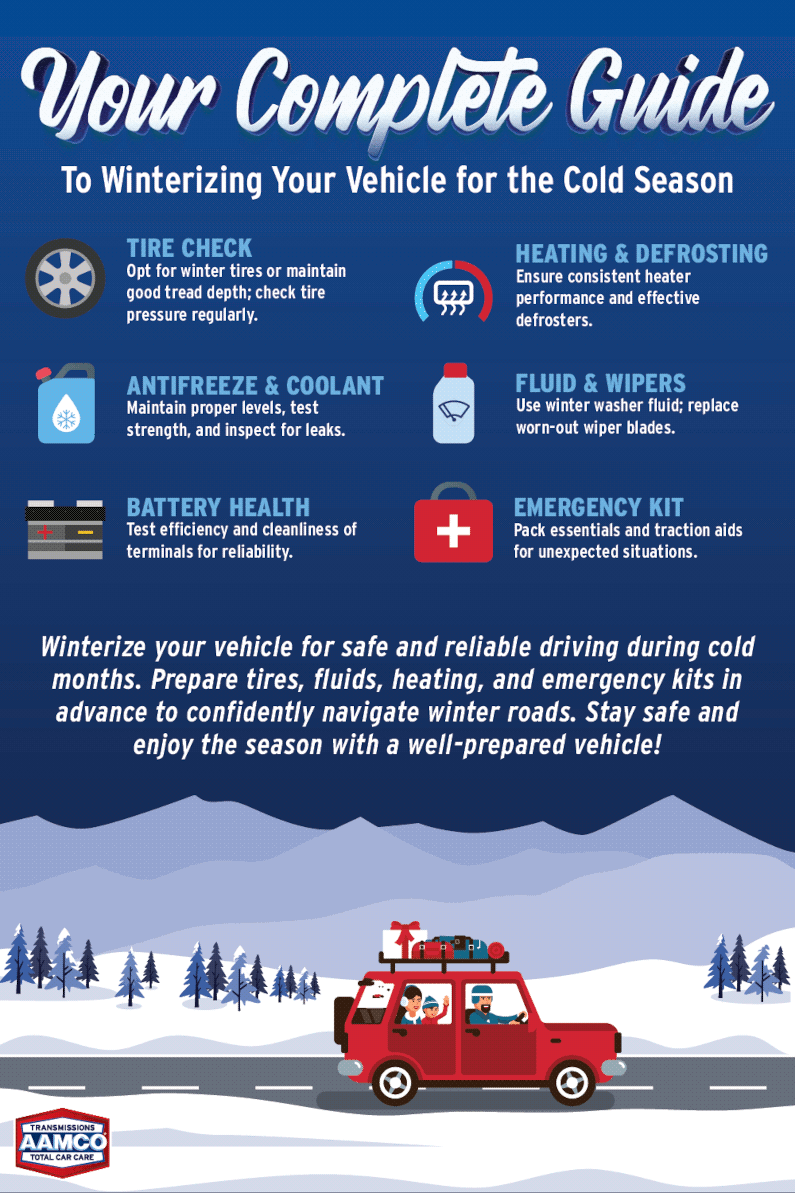Your Complete Guide to Winterizing Your Vehicle for the Cold Season
Get ready for winter with our comprehensive guide on preparing your car for the cold. Learn about winter tires, antifreeze, heating systems, and more.
AAMCO | 11/22/2023
As the temperatures drop and the first snowflakes start to fall, it's crucial to prepare your vehicle for the challenges of winter. Cold weather and icy conditions can take a toll on your car, potentially leading to safety hazards and mechanical issues if not properly addressed. From installing snow tires to checking antifreeze levels and ensuring your heater works efficiently, here's a comprehensive guide on how to winterize your vehicle and keep it running smoothly throughout the frosty months ahead.

1. Evaluate Your Tires
Your vehicle's tires are your first line of defense against winter driving hazards. Switching to winter-specific tires or all-season tires with a good tread depth is essential for improved traction on icy and snowy roads. Here's what to consider:
Snow Tires: Consider investing in dedicated snow tires designed to handle cold temperatures and provide a better grip in snow and ice. These tires are specifically engineered with unique tread patterns and rubber compounds for winter conditions.
Tire Pressure: Check tire pressure regularly as cold weather can cause it to drop. Properly inflated tires ensure better handling, fuel efficiency, and traction. Refer to your vehicle's manual for recommended tire pressure levels.
Tread Depth: Ensure adequate tread depth on your tires. The legal minimum is typically 2/32 of an inch, but for better winter performance, consider replacing tires when the tread depth reaches 4/32 of an inch.
2. Verify Antifreeze and Coolant Levels
Antifreeze, also known as coolant, plays a crucial role in preventing your engine from freezing in cold temperatures. It's essential to check the antifreeze levels and the condition of the coolant system components:
Coolant Levels: Check the coolant reservoir to ensure it's filled to the recommended level. Use a mixture of antifreeze and water as specified by your vehicle's manual.
Antifreeze Strength: Use an antifreeze tester or visit a mechanic to check the strength of your antifreeze. It should be able to withstand the coldest temperatures in your area without freezing.
Radiator and Hoses: Inspect the radiator and hoses for any leaks, cracks, or signs of wear. Replace any damaged components to prevent coolant leaks that could lead to engine overheating.
3. Assess Battery Health
Cold weather can be tough on car batteries, reducing their efficiency and capacity. Follow these steps to ensure your battery is ready for the winter months:
Battery Test: Have a mechanic test your battery's voltage and overall health. Weak batteries are more prone to failure in colder temperatures.
Clean Terminals: Clean the battery terminals and cable connections to prevent corrosion, which can hinder proper electrical flow.
Consider Replacement: If your battery is old or showing signs of weakness, consider replacing it before winter sets in to avoid being stranded due to a dead battery.
4. Ensure Efficient Heating and Defrosting Systems
A functional heating and defrosting system is essential for your comfort and safety during winter driving. Here's what you can do to ensure they work efficiently:
Heater Inspection: Test your vehicle's heater to ensure it's blowing hot air consistently. If you notice any issues, have it inspected by a mechanic.
Defroster Functionality: Check the front and rear defrosters to ensure they effectively clear fog and ice from your windows. Replace worn-out wiper blades for better visibility.
5. Check Fluid Levels and Wipers
Proper fluid levels and functioning wipers are essential for visibility and safe driving in winter conditions:
Windshield Washer Fluid: Use a winter-specific windshield washer fluid that won't freeze in low temperatures. Keep the reservoir filled to ensure clear visibility.
Wiper Blades: Inspect and replace worn-out wiper blades for optimal performance. Streaks or skipping indicate the need for replacement.
6. Stock an Emergency Kit
Be prepared for unexpected situations on the road by assembling an emergency kit for your vehicle:
Essentials: Include items like a flashlight, extra batteries, blankets, non-perishable snacks, a first-aid kit, jumper cables, a shovel, and a portable phone charger.
Traction Aids: Keep sand, kitty litter, or traction mats in your trunk to help gain traction if your vehicle gets stuck in snow or ice.
Winterizing your vehicle is crucial to ensure safe and reliable driving during the cold months. By following these comprehensive steps, from preparing your tires and checking fluid levels to verifying the heating system and assembling an emergency kit, you can proactively address potential issues and confidently navigate winter roads. Don't wait until the snow starts falling heavily; take these steps in advance to ensure your vehicle is ready to handle whatever winter throws your way. Stay safe and enjoy the season with a well-prepared vehicle!


